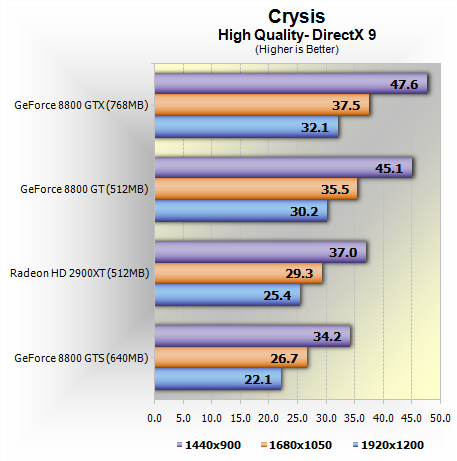DirectX 9 Performance
Test System Specs: Hardware
- Intel Core 2 Duo E6700 (2.66GHz) LGA775
- x2 1024MB Corsair XMS PC3-10600 CAS7 Module(s)
- ASUS P5E3 Deluxe (Intel X38)
- OCZ GameXStream (700 watt)
- Seagate 500GB 7200RPM (Serial ATA II)
- Nvidia GeForce 8800 GTX (768MB)
- Nvidia GeForce 8800 GT (512MB)
- Nvidia GeForce 8800 GTS (640MB)
- ATI Radeon HD 2900XT (512MB)
- ATI Radeon HD 2600XT (512MB)
- Nvidia GeForce 8600 GTS (256MB)
- Nvidia GeForce 8600 GT (256MB)
- ATI Radeon X1950 Pro (512MB)
- Nvidia GeForce 7900 GT (512MB)
- Nvidia GeForce 7900 GS (256MB)
Software
- Microsoft Windows XP Pro 32bit (SP2)
- Nvidia Forceware (169.01)
- ATI Catalyst (7.10)
- Intel System Drivers (8.4.0)

This first batch of results paint quite an ugly picture. Unfortunately the jaw dropping graphics on Crysis will only be fully enjoyed by the minority of gamers due to the hefty toll on system performance.
The recently announced GeForce 8800 GT is a more affordable solution than both the GTX and GTS, yet its performance looks incredible, just shy away of reaching GTX's kind of raw power.
Interestingly while the GeForce 8800 GTX only managed 32fps at 1920x1200 using high quality settings, I found it to be very playable. In fact I played throughout the entire first level with these settings and found it very enjoyable. What I did notice is that the frame rates in Crysis do not tend to fluctuate all that much or at least they didn't in the first level. This allowed for uninterrupted gameplay at 1920x1200 with an average of 32fps.
"Lower" resolutions like 1680x1050 and 1440x900 worked just as well as you can imagine. The Radeon HD 2900XT was limited to 1680x1050, as was the 8800 GTS for playable performance. In fact the 8800 GTS did better using 1440x900 where it rendered just 34fps on average. So far this means the GeForce 8800 GTX/Ultra are the graphics cards to use with Crysis without going dual.

There was just no way or reason to test mid-range graphics cards using the high quality settings based on the performance received by the Radeon HD 2900XT and GeForce 8800 GTS. Therefore we took it a down a notch down to medium quality which still offered well above average graphics.
The 1920x1200 resolution was also scrubbed as not even the fastest graphics card of the mid-range pack (the Radeon HD 2600XT) was able to deliver playable performance at that resolution. From the results we can clearly see most gamers are going to have to use 1280x800 to achieve playable performance (or upgrade!).
The Radeon HD 2600XT performance was the most impressive of the mid-range pack as it slightly managed to edge out the Radeon X1950 Pro and easily defeated the GeForce 8600 GTS along with the GeForce 7900 GT. The GeForce 8600 GT performance was quite poor and the 7900 GS did very poorly as well. Clearly those with mid to low-end graphics cards are going to have to use a combination of low and medium visual quality settings.
For comparison purposes we have also included the three high-end graphics cards and as you can see in most cases they are two or more times faster than the mid-range contenders. There is a very significant jump when going from the GeForce 8600 GTS to the 8800 GTS, for example.
